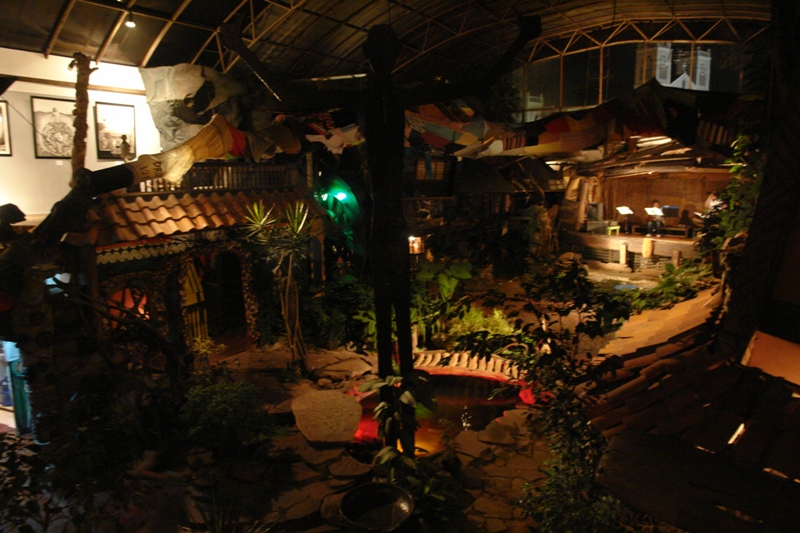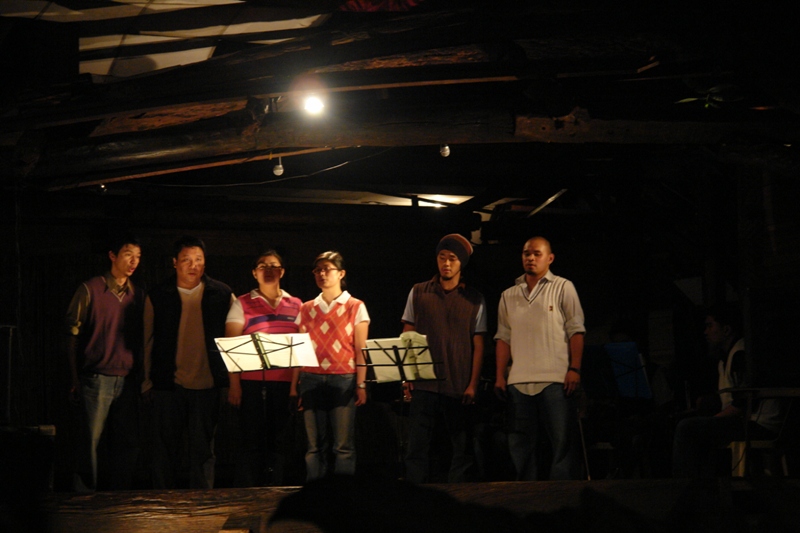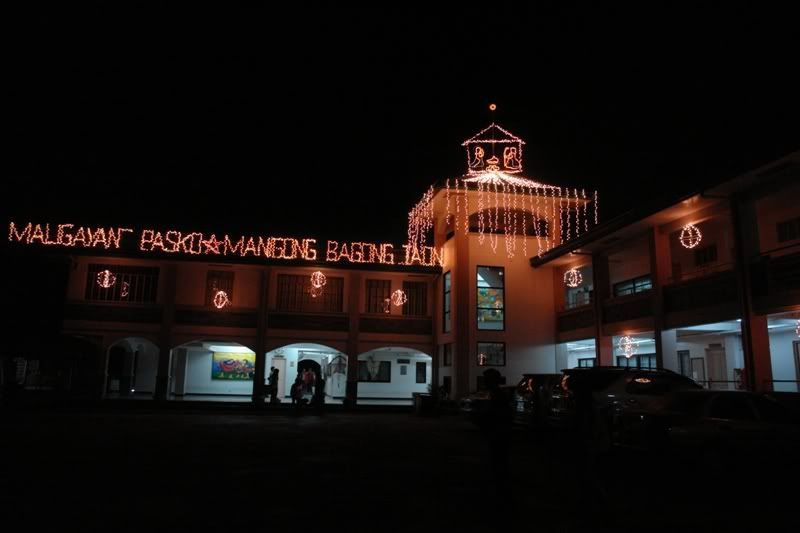Friday, December 21, 2007
In Search of Baguio & Sagada: Epilogue
The entries in this blog – textual and visual - are of course the best witness to some of the many exciting episodes that transpired in this particular trip. But, in no small measure the challenging and spectacular physical and cultural landscapes of the Cordillera region, the powerful stories of struggle, vision and hope shared by the groups we met, and the youthful enthusiasm and spontaneity of this cohort of travelers made the many months of preparation insignificant. The few unexpected twists and turns cropping up along the way also infused this trip with a distinctive character that only my co-travelers can know and share.
A journey of this nature would not be possible in the absence of the assistance of a number of institutions and individuals. I would like to thank the Cordillera Studies Centre of the University of the Philippines, Baguio City Campus for kindly consenting to be the host institution, and for identifying energetic and knowledgeable student guides for the journey. In addition to her own valuable insights into the many issues faced in the region, Mary Carling provided key assistance in logistical preparations and facilitating cross-cultural bridges for us. Last but not least, the generosity of knowledge shared by the many groups and individuals that we met along the way will remain lodged in our hearts.
If there are any learning points that my fellow travelers can discern from this year’s trip to what may seem to be exotic and unfamiliar lifeworlds, I believe there are two. Firstly, it is the tenacity of the human spirit in search for better livelihoods as embodied in the courageous daily struggles of local communities and civil society groups. And, secondly, the singular wisdom and necessity of valuing and protecting cultural diversities wherever they may be found in order to shape a more convivial place for all. Whilst the study trip has ended, that part of the journey remains in motion.
By YSG
Day 10: Signing Off
But in all honesty, I do know that going to Baguio and Sagada was a very eye-opening trip, not just in the tourist sense of knowing I saw the culture and experienced the sights, sounds and taste of the place. But that I also learnt something about myself. About how I adapt in different circumstances and how I’ll mostly see myself as the person who observes and hopefully try to remember what I’ve seen.
This blog is an accumulation of the many groups we visited, the personal experiences we had from the downright eye-popping ones to the more awe-inspiring occurrences of nature and even the gut-popping and heart wrenchingly funny and sad incidents we saw and heard. Of the many names and faces of people we met, we’ll surely have forgotten half their name but knowing the cause that they fight doesn’t end here but that it continues till a certain plateau is reached before they can afford to rest and then continue on.
One special mention I wanted to take note of is that the Sagada National High School is still lacking one computer for their technology class. Mindy, you still up for raising funds for them? Maybe we as a group could find some means to raise the money for them.
Here are some places that were not mentioned.
We visited Oh My Gulay, a gallery-restaurant (which literally means Oh My Vegetable, which brings to mind the phrase, vegetroubles), a hip and happening place with an artsy vibe and a basic menu of mostly pasta and salads. Kidlat Tahimik the world renowned film director and Baguio City local owns the place.


The Minstrel, an A Capella group worth mentioning was singing at Oh My Gulay the night we were there and also during the 2nd mini Christmas concert in UP Baguio on the 20th of December. I thought the group had a pretty good harmony worked out between them and the choice of songs worked to their voices too.

Quirino Hill near the CPA office really caught my attention, it literally looked like there were houses growing out of it as the houses were built at very close proximity to one another. And as Maya noted, the houses are growing at a rate of mushrooms in Baguio City.

It was also interesting to note that even God’s animals (dogs) were welcomed visitors at His house, in Sagada. I like to think that it’s because it’s a village and people weren’t too picky (as such, I’m sure the Malaysian churches would be horrified to allow dogs into the church sanctuary). I’m just glad I got to see how church is conducted away from home, as it gave me a different perspective on a similar faith I myself practice.

Five names must be mentioned and graciously thanked. Janice Bagawi (Maya), Macario Lacbawan (Mac), Rommel de Guzman (Rommel), Maureen Macaraeg (Mau) and Chinee Palatino (Chinee). Lastly also Mary Carling, the one who got things off the ground for us from the Philippines. Thank you very much all of you for the effort and time you took to help us all through the ins and out of a language that can sometimes sound vaguely familiar yet isn’t very much so.
Two quotes come to mind at the end of a post like this.
One:
Some people come into our lives and quickly go.
Some stay for a while, leave footprints on our hearts.
And we are never, ever the same.
Two:
Goodbyes are not forever.
Goodbyes are not the end.
They simply mean I'll miss you.
Until we meet again!
I actually have no idea who wrote the above lines but I thought the short poems very nicely explained how most of us would feel at the end of the trip, from both the Malaysian and the Filipino parties.
So I pray that as we all left Baguio and Sagada with our eyes and heart opened a little bigger and wider. To understand that our world isn't as small as it seems and how much can be achieved if we just put our heart and minds to it.
Editor-in-Chief
Shu Yi
An Ode to Baguio
 To say the least, Baguio has flouted my initial assumptions of the city. The pictures I saw over the internet in research before coming here did not betray many things, such as the very strange traffic “rules” (or lack of), which by Malaysian standards, will shock the most seasoned of KL pedestrians. For the information of those who do not know, the traffic in KL is bad and trust me, that, is an understatement. Still, for those who want to travel here, the trick seems to be, that we walk in packs; because then, they will have to stop for you. We often forget that they drive on the opposite side of the road and just tonight, I screamed at the glaring headlights of an oncoming taxi because I forgot to look right after I looked left and crossed. A friend from the group and I joked the other day, that Filipino drivers have their hands surgically attached to their car horns.
To say the least, Baguio has flouted my initial assumptions of the city. The pictures I saw over the internet in research before coming here did not betray many things, such as the very strange traffic “rules” (or lack of), which by Malaysian standards, will shock the most seasoned of KL pedestrians. For the information of those who do not know, the traffic in KL is bad and trust me, that, is an understatement. Still, for those who want to travel here, the trick seems to be, that we walk in packs; because then, they will have to stop for you. We often forget that they drive on the opposite side of the road and just tonight, I screamed at the glaring headlights of an oncoming taxi because I forgot to look right after I looked left and crossed. A friend from the group and I joked the other day, that Filipino drivers have their hands surgically attached to their car horns.Yet just as the saying goes, “never judge a book by its cover”, one must not judge a city merely, by its traffic. Baguio holds many little wonders for those who can see past its unashamed forwardness and little offences (such as safety for tourists – we are warned of the many pickpockets roaming the streets), to see the beauty and hospitality of it's local inhabitants. Till today, I still cringe when a much older woman salesperson calls me, “ma’am”. One only has to recall the hawkers back home to know the value of good manners. Many people here mind their p’s and q’s.
A word of praise goes out to our student guides, volunteers from the University of Philippines, Baguio campus Maya, Mau, Mac, (the three mighty M’s) and the adorable Chinee and Rommel. Frankly, I think we gave them more than they bargained for; with our often ignorant questions and shameless and constant harassment, it is a wonder they did not run for their lives on the very first day. To you all, I say thank you on behalf of my uni-mates. May God return you your sanity so that you can continue your lives where you left off before we invaded your perfect city and healthy minds.
To the organisations that hosted us for the past ten days, a very big Salamat. It was an honour to understand the cause that you fight for everyday of your lives - that we, from a very privileged nation, in which its people often take its prosperity and freedom from grave poverty and other struggles for granted, cannot begin to fathom. My wish is that in my understanding of your battles, I will remember to repeat you, and your cause to everyone I meet, so that they, and I, might remember the smaller things in life.
As an aspiring academic, I now know that what is said in endless and often forgotten tutorial discussions on intricate issues like poverty, women’s issues, equality, economics, and the role of government, the talk ends when the clock’s second hand strikes 12 to mark the end of the hour, and we all leave to meet our friends at the local Starbucks. Your fight, on the other hand, is real. Your fight is noble. Your fight is bold. Your fight will be won.
By Melissa
Thursday, December 20, 2007
Day 9: A Bollywood Ending
Well, the first thing we did in the morning, was the visit to Camp John Hay. It was an eventful visit, simply because of the numbing walk uphill and of course the making of Aaron’s Bollywood musical flick. But, before I go there, it is worth mentioning that we went to a very classy hotel indeed, can’t remember the name though (Ed: it’s called Camp John Hay – The Manor Hotel). Just to enjoy the environment and use the comfort rooms (known as toilets and restrooms in Malaysia) of course. The point I wanted to make, well actually Susan made me realize, was that there is a vast and obvious difference between the rich and the poor in the Philippines. Here we see rich guests mostly from foreign countries with their expensive coats, Gucci handbags and an aristocrat feel about them and after witnessing the poverty going around Baguio City, the world seems to be really quite cruel.
After the hotel visit were more excruciating walks uphill and finally to the spot to film Aron’s newest production. We all tried out best to dance although honestly I think we looked like a bunch of monkeys getting excited. The best part of it was definitely Rommel and Mau running around in D-I-Y slow motion mode. It was simply hilarious. After all the hard work, all of us being actors and all, got tired, and me as usual, got hungry. So off we went to find food and we ended up at what was that name again? Sorry I forgot, told you, old age catching up. Anyway, it has one of the best burgers I’ve tried, I think Aron would agree with me or he would probably still choose the ever so wonderful 7/11 hotdog.
Well, fast-forward till night and we attended an annual Christmas concert at UP Baguio and we rocked the house down.

The dancing lessons this morning seriously paid off as Monash students simply took center stage. Right back at ya UP Baguio peeps! We were then treated to a very nice dinner by our very own Prof. Daniel. Thanks a lot sir, I appreciate it, the rest as well I’m sure. Then came the emotional goodbye at a music bar of all places (Ed: it’s Ayuyang Bar at Governor Pack Road.) The emotional goodbye was spearheaded by Jojo and Pooi Yarn who both eventually began a chain reaction. But anyways, I love you guys to bits, best friends forever. So that’s it, I am in Manila now and you guys are missing out a lot, seriously, wish you guys were here.
P/S Me and Susan got harassed by a street thug on the way to the CC to do this story. One of the many sacrifices I go through to help complete this blog. (Ed: and the editor sincerely thanks both of you for sparing time on your short Manila trip for the life of this blog =)
By Zeck
Three
Exams are taken by fools
[im]press[i]ons
Owing to my ignorance of Malaysia, I was surprised that our visitors from Malaysia spoke good English. I expected them to be like the Koreans and Japanese in the city who spoke a halting and simplified English. While observing them the first day, I came up with a tentative hypothesis that these students spoke English so well because they belonged to the upper middle class, if not upper class families. I based that on the situation in the Philippines where a good command of the English language is a status symbol, and it may be said that children of rich families speak English as their first language. I found out later though, that there are three races in Malaysia, namely the Malays, the Chinese, and the Indians, and they have to speak English in order to communicate. So much for my hypothesis. Nevertheless, rich kids or not, these students from Monash University aren't bratty at all, thank goodness. They are actually very eager to learn as much as they can about Baguio and Sagada. During lectures and discussions with the various groups we met they were always teeming with questions, no matter how soporific the session had been.
Nosebleed aside, being with eighteen students from Malaysia during their stay here was almost like being a tourist myself. Seeing the city I grew up in and the province where my parents grew up in through the eyes of first-timers allowed me to experience things I had taken for granted-- mountain scenery, bumpy winding roads, hiking, cold weather, rainbows, balut and one day old chicks--with child-like excitement. They say they came here in search of Baguio and Sagada, and I hope they found it.
I did, through their eyes.
By Maya
Session Road

Unlike most busy streets in US, Europe and some parts of Asia, Session Road, I noticed has few, if not, no bill boards along the streets. You will, however, find many residents and visitors still enjoying their climb up and down the hilly streets of Session Road. Session Road is the main pathway across Baguio city and it happens to be the city’s main commercial district. This is where you will find establishments ranging from food to fashion and accommodations. A variety of stores, bazaars, restaurants and banks are just a few examples of what you can find on Session Road. As a result, Session Road is often crowded with people, mostly Filipinos coming from the lowlands to enjoy the cool weather in Baguio.
However, the crowds on Session Road could spell trouble especially to tourists as they would mostly like be in possession of more cash compared to locals. I myself, thankfully, never encountered any problems but the warnings you get about pickpockets and handphone snatchers does keep me on alert mode, as it’s better to be safe then sorry I guess. Being in restaurants and shops however, ensures your safety as there are security guards, as weird as it may sound in these places. Going into a mall will get you searched and possibly walking through a metal detector. Walking down Session Road is no doubt, a lot of fun, especially window shopping, looking at different types of people conducting all forms of trades or just simply walking down this lengthy road. It is advisable however, to spend more time walking along Session Road during the night as the pollution is not as bad then.
Well I guess that would be everything, in a nutshell of course, on what you should know about Session Road. I am sure that there are more alleys and lanes that branch out from Session Road ready to be explored so that is exactly what I am going to do now. Session Road, here I come!
By Zeck

























